Wasps v moths: Biocontrol uses nature against crop pests
- Published

Humans may consider wasps a pest, but some can be used to protect crops
Blinking in the blazing Brazilian sun, a farmer looks up at the sound of an aeroplane, flying low over his sugarcane plantation in Sao Paulo.
A hatch suddenly opens, and a white cloud emerges.
It may look like pesticide, but these are live eggs falling down - from wasps.
Once hatched and grown, the insects inject their own eggs into those of the sugarcane borer - a moth that in its caterpillar stage eats valuable plants - preventing the pest from hatching.
A number of farmers in Brazil have swapped chemicals for wasps, in a country that has recently outgrown the US as the largest consumer of pesticides.
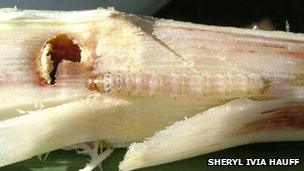
Sugarcane borers eat the plants and can be detrimental to the plantation
The biotechnology firm that is fighting nature with nature - what is known as biocontrol - is Bug Agentes Biologicos, or simply Bug, based in Piracicaba, Sao Paulo.
"Egg-spraying" from a plane is just a trial - at the moment, the wasps' eggs are put on pieces of cardboard and distributed throughout the field. But Bug wants to start using a plane later this year, once the technology is more reliable.
Bug mass-produces Trichogramma galloi, a breed of wasps able to parasitise moth eggs. One wasp can lay its eggs in more than 50 moth eggs in its short life of up to two weeks.
Last year, the firm made it on to the list of the world's top 50 most innovative companies, compiled by US business magazine Fast Company. Forbes called it one of Brazil's top 10 most innovative firms.
The technique isn't new - but the main innovation is in breeding the wasps on an industrial scale.
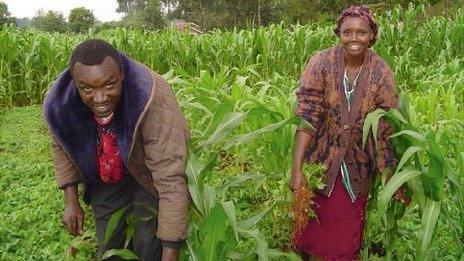
In Kenya, some farmers attract pests with trap plants, then lure them away with another crop
"They are very specific, only multiply in eggs of butterflies and moths, [and do] not cause harm to humans or plants," says Bug's director, Diogo Rodrigues Carvalho.
According to the company, in the past two years, Bug has treated an area of 500,000 hectares (5,000 sq km) of sugarcane in Brazil.
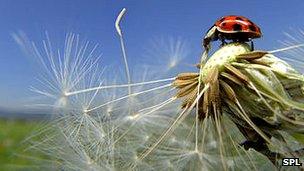
Harlequin ladybirds eat pests but also other beneficial insects
Biocontrol is an area of biotechnology that involves moving away from toxic chemicals, either by mass-producing a pest's natural enemy or by introducing an exotic species to attack the pest.
Currently, biocontrol is receiving a lot of attention, says Dr Toby Bruce of Rothamsted Research in the UK.
"It is increasingly important as EU legislation is restricting the use of conventional pesticides," he says.
"Consumers are demanding chemical-free products, and pests are continually evolving resistance to the pesticides currently available.
"[Also,] many pesticides are broad spectrum and kill the natural enemies of the pests as well as the pests themselves."
Tree 'vaccination'
Both a pest and its natural enemy can be anything from an animal to fungi to bacteria.
For example, scientists at CABI, a not-for-profit UK agricultural research organisation, hope to study fungi that exist within ash trees, to fight against the ash dieback disease.
The disease has infected some 90% of the species in Denmark, and is threatening the UK's ash population.
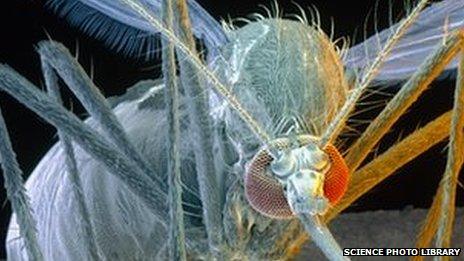
Researchers genetically modified mosquitoes that carry dengue fever, making them sterile
Caused by the fungus Chalara fraxinea, its symptoms can include brown leaves, lesions and dark wood.
"There is a group of fungi called which are endophytic - living inside plants without causing them any trouble," explains Dr Dick Shaw of CABI.
"There must be a benefit to the plant - such as pest resistance.
"Ash dieback disease is an exotic disease, and the concept we have is that in its area of origin, the endophytic fungi are the natural enemies that exist within the plant - and we could use them like a vaccine to protect the tree against this disease."
The team has successfully trialled the method with cocoa plants in South America, and will soon propose the research on ash trees.
Another type of biocontrol is making an organism sterile.
Researchers at Oxitec, a spin-off from Oxford University, have done it to mosquitoes, genetically modifying them.
But before that, they looked into using radiation to sterilise fruit flies, a pest in many places.
"You swamp the population with sterile male flies, they mate with females but don't give any productive offspring," says Dr Shaw.
Some researchers have looked even further than that.
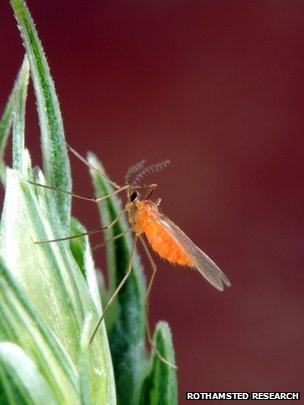
Orange wheat blossom midges damage wheat and can be difficult to control with insecticide
In New Zealand, bushtail possums are considered a pest., external
They were taken there in the 1830s from Australia for their fur. But with no natural enemies, their population has soared, savaging local wildlife like the endangered kiwi bird and infecting cattle with bovine TB, say the authorities, external.
Traps and poison are traditionally used, but scientists from New Zealand's National Research Centre for Possum Biocontrol studied how to make possums infertile.
The idea was to genetically modify tiny parasitic worms that naturally live inside the possum's intestine - nematodes - to produce special chemicals.
Once the modified worms were put into a possum, they would make the animal sterile.
The research, however, was halted some time ago because of a lack of funding.
Too risky?
But what if something were to go wrong?
"In a biological system you can never be 100% certain what the outcome will be, so you need to manage your risks," says Dr Shaw.
For instance, in 1935 cane toads were taken to Australia from South America to fight the cane beetle - an insect harmful to sugarcane crops.
But since the toads can consume almost anything, their population exploded, quickly reaching more than 200 million and harming local wildlife.
"That was an act of insanity, really, against all of the scientific knowledge at the time," says Dr Shaw.
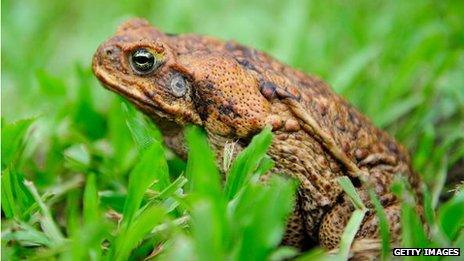
Importing cane toads into Australia to battle a beetle backfired.
And the outdoor release of harlequin ladybirds, used to eliminate aphids - plant lice - is also "an example of an absolute disaster".
"This ladybird is a massive predator that will eat absolutely everything - including itself - so that's not a sensible biocontrol agent outside the glasshouse," he says.
To ensure that the biological agent will do what is expected of it, scientists have to complete a pest risk and a risk-benefit analysis.
And the exotic organisms have to be carefully selected to attack only what you want them to attack, says Dr Shaw.
"You have to be extremely careful."
- Published19 September 2012
- Published30 October 2011